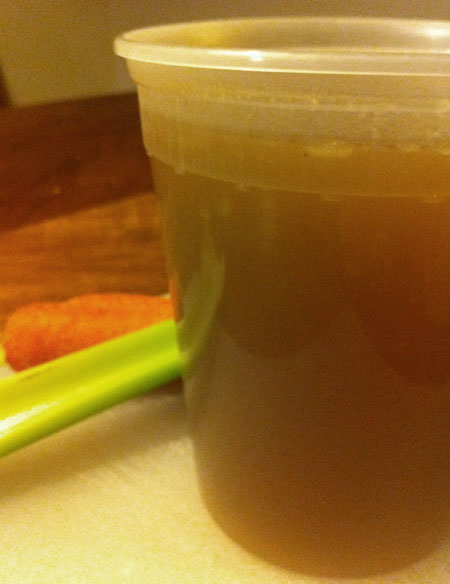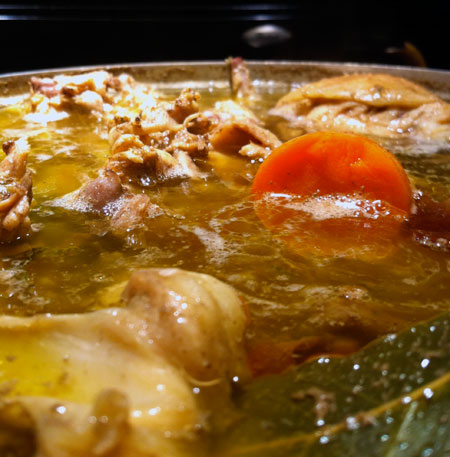If there was a periodic table of cooking, stock would be carbon—it’s the building block of pretty much everything. And it’s made from all the leftover bits you can’t really eat—bones, carcasses, necks, and I’ve even heard many people swear by using chicken feet in their stock. Veal stock may the elemental base for most of classical French cuisine, but unless you have a hankering for real demi-glace, most home-cooking applications do just fine with the much-easier-to-come-by chicken stock.
Making your own chicken stock might take a couple hours, but you don’t have to do anything to it for the vast majority of those hours. And when you make stock at home, you control the ingredients. The canned and boxed stuff at the grocery store has way to much preservatives and salt and who-knows-what-garbage in it.
Next time you want chicken, buy a whole bird instead of boneless, skinless parts. Roast it (how to do that is a future post), enjoy it, and then freeze the carcass in a zip-top bag. Do this one more time and you’re ready to make stock. (Or you can break a whole chicken down yourself and save the bones, neck, and carcass, or you can buy some chicken necks, backs, and/or feet at the store—whatever.)
One important thing to remember: DO NOT SALT THE STOCK! You’ll add salt when you use it to make a final dish. Some recipes call for boiling stock down to make a thick sauce, and if you salt it while you’re cooking, you’ll end up with something way to salty after reduction.
The great thing about stock is that it freezes perfectly and can stay for months, if not years. I make a batch every few months, so I always have a Delitainer or two of frozen stock on hand. I used to freeze the stock in ice cube trays so I could just grab as many cubes as I needed, but that’s more of a hassle than it’s worth; you can thaw and refreeze stock multiple times without any problems.
Chicken stock is of course the basis for just about every soup on earth, but that’s far from its only use:
- Use it in place of water to cook rice, other grains like bulgur or barley, beans, or peas
- It’s the main liquid in fall favorite risotto
- Mix it with a roux to make gravy
- It can be used as the base of sauce veloute and espagnole, two of the five French mother sauces, and the main ingredient in pretty much every other sauce
- Cook it down and add a bit to a vinaigrette for a savory salad dressing
Chicken Stock
Makes 3 to 3 1/2 quarts
1/2 head celery (4 to 5 stalks), roughly chopped
4 to 5 medium carrots, with greens, roughly chopped (if you don’t have greens, use 1 bunch parsley instead)
1 large or 2 small yellow onions (unpeeled), quartered
About 2 pounds chicken bones, necks, carcasses, feet, etc.
3 cloves garlic
1 tbsp. whole black peppercorns
3 bay leaves
Place celery, carrot, and onion in a large stockpot over medium heat. Add remaining ingredients and cook without stirring until vegetables begin to brown, about 10 minutes. Fill pot with water to cover all ingredients and within about an inch of the top. Bring to a boil, reduce heat to a low simmer, and cook 2 hours. (You should see an occasional bubble come to the surface, but no rapid bubbling. If stock boils, reduce heat.)
Strain stock through a colander into a large bowl or another pot. Discard solids. If desired, strain again through a chinois or other fine strainer. Refrigerate stock 6 to 8 hours or overnight, until fat floats to the top and solidifies. Skim and discard fat, and freeze stock for future use.

